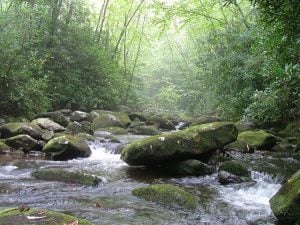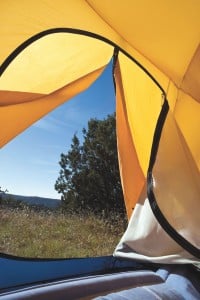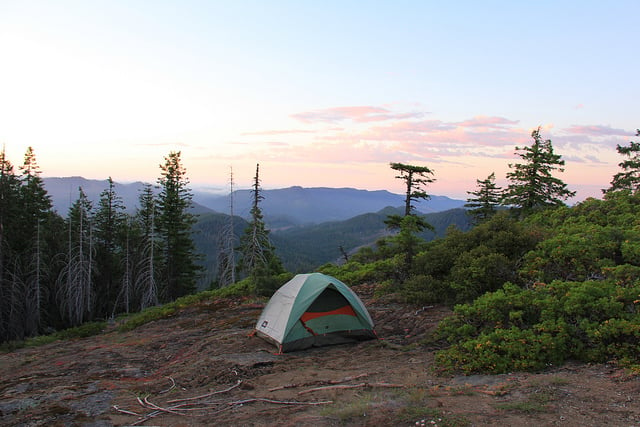Driving into the woods and setting up camp only a few feet from your bumper may not have the same cache as hauling a 50-pound backpack into the middle of nowhere. But the truth is, some of the South’s best adventures begin at family campgrounds and more secluded forest road campsites. And here’s the best part: Come November, these car camping adventure-lands are largely absent of the RVs and crowds. Here are a few of our favorites.
Warden Fields
Citico Creek Wilderness, Tenn.
It’s not easy to car camp inside a federally designated Wilderness area. Actually, it’s illegal, which means by and large, campers who want to enjoy the solitude and pristine nature of our Wildernesses must backpack. But the Citico Creek Wilderness in Tennessee’s Cherokee National Forest is bordered by the Citico Creek Road. And along Citico Creek Road are pristine car camping sites, many of which hug the banks of Citico Creek itself. By far, the most desirable site is Warden Fields, a large clearing that was once the base of operations for logging companies who needed to access the steeps that now comprise Citico Creek Wilderness. Today, Warden Fields serves as a primitive base camp for day hikers looking to explore the Wilderness and surrounding mountains.

Citico Creek is a 16,226-acre Wilderness known for its wet creek crossings and high density of bears. Warden Fields serves as the trailhead for four hiking trails that climb deep into the Wilderness.
Hike This: All of the trails beginning at Warden Fields can be connected to create loops. Pine Ridge Trail is 3.5 miles of singletrack that climbs 2,000 feet before joining Fodderstack Trail (which is also part of the Benton Mackaye Trail). Views are scattered along your ascent, but you can take a side trip up Big Fodderstack if you’re looking to bag a peak. Brush Mountain Trail (4.4 miles) connects the South Fork Citico Creek Trail with Warden Fields. The South Fork and North Fork Citico Creek Trails each follow and cross their respective forks, joining at Fodderstack at the N.C. border. Together, they make a beastly and wet 15-mile loop. For a shorter hike, Flats Mountain Trail (6.1 miles one way) begins at Beehouse Gap on Citico Creek Road not far from Warden Fields. The trail climbs one thousand feet to Flats Mountain, then switchbacks along the ridgeline, offering views of 5,000-foot peaks.
 Deep Hole Recreation Area
Deep Hole Recreation Area
Chattahoochee National Forest, Ga.
Location, location, location: that’s what makes Deep Hole such a coveted base camp for exploring North Georgia’s mountains. The small, primitive campground (no electricity, no showers) sits on the banks of the Toccoa River, just a few miles south of Lake Blue Ridge, within prime striking distance to some of the Chattahoochee National Forest’s best recreation. The Appalachian Trail and Benton Mackaye Trail intersect a few miles from the campground, one of Georgia’s best mountain bike systems is just up the road, and winter views can be had from nearby peaks. The campground is also the put-in for the 17-mile Toccoa River Canoe Trail.
Hike This: The Benton Mackaye Trail crosses Highway 60 a few miles north of Deep Hole. You can follow it south to the suspension bridge across Toccoa River (three miles in) or go nine miles to the Bald, a man-made clearing that sits at 3,250 feet with views of Springer Mountain. This is one of the most remote sections of the BMT, featuring 1,300 feet of climbing from the Toccoa River to the Bald in a roller coaster ride of ascents and descents. The Appalachian Trail crosses Highway 60 at Woody Gap. From the gap, hike a mile north to Big Cedar Mountain, which has one of the best views along the first 30 miles of the A.T. Push your day hike a mile farther north and you can bag Granny Top Mountain and pick up the Dockery Lake Trail, which drops for three miles off the ridgeline via rocky, creek-side singletrack. Arrange for a shuttle and you can follow the trail all the way down to the tiny, trout stocked lake of the same name. The 9,649-acre Rich Mountain Wilderness has a similar ecosystem to the more popular Cohutta Wilderness, but only a fraction of the users. If you’re willing to bushwhack it, there are miles of old logging roads inside Rich Mountain’s boundaries, some of which take you past amazing winter views and old Native American camps.
 Yellow Gap Road
Yellow Gap Road
Pisgah National Forest, N.C.
The amount of high quality singletrack, long range views, rock faces, and waterfalls inside the Pisgah Ranger District should be illegal. This 16,000-acre outdoor oasis is one of the most popular national forest districts in the country. But don’t worry about crowds come November. If you want car camping with a bit of solitude, look for a spot on Forest Road 1206, more commonly known as Yellow Gap Road. The Yellow Gap winds from the North Mills River Recreation Area to the Davidson River Recreation Area, connecting two of the most popular recreation destinations in North Carolina. Classic Pisgah hikes fan from the road in either direction, and dozens of primitive campsites can be found tucked beneath the forest canopy just off the gravel road. There’s a particularly sweet spot that sits on the edge of Bradley Creek between the Pilot Rock and Pilot Cove trails.
Hike This: Pilot Rock Trail is a 3.6-mile rock-laden beast of a climb that leads to massive views from a rocky outcropping. Bring your crash pad and climbing shoes and you can try to send some of the massive boulders that line the trail along the way. You’ll climb 1,500 feet in one brutal two-mile stretch. Looking Glass Rock Trail climbs 1,700 feet in 3.2 miles, rewarding hardy hikers with astonishing views from two cliffside perches. The trail switchbacks up the forested side of Looking Glass Rock, which is one of the hottest rock climbing destinations in the South. Take a side trail from the old helicopter pad for views from Lower Looking Glass Cliffs, and get even better views from the culmination of the trail at Upper Looking Glass Cliffs. For an easier hike, take Moore Cove Trail, a relatively flat 1.5 mile out and back with the sublime 50-foot Moore Cove Falls sandwiched in the middle. Depending on the weather, the falls is either a rollicking cascade or trickle. Either way, the massive rock cliff it tumbles over is worth the short hike alone.
Related:







